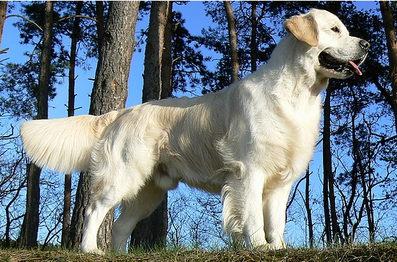
Testing of dogs: Locus E
Related tests
- Combination Dalmatian ARDS + DM (SOD1A) + HUU + locus E
- Combination Poodle NEWS + prcd-PRA + rcd4-PRA + DM(SOD1A) + vWD1 + GM2 + loci E and B
- Combination Puli DM (SOD1A) + PLL + PRA-prcd + vWDI + BBS4 + Locus A + Locus E + Locus K, KB allele only
- Combination Shiba GM1 + GM2 + Locus A + Locus E
- Combination coat colors + coat length in dogs Loci A + B + D + E + I + KB and coat length M1, M3, M4, M5
- Combination coat colors in Geat Dane Loci A + D + E + EM + I + KB + harlequin
- Combination coat colors in dogs Loci A + B + D + E + I + KB
- Combination coat colors in dogs, extended Loci A + B + D (d1, d2, d3) + E (EM, eG,eH, e1, e2, e3) + I + KB
- Locus E + EM complete test of E and EM loci
E Locus (Extension)
For an overview of dog coat color hierarchy continue to the article Introduction into coat color in dogs.
The expression of E locus is affected by MC1R gene that is located on the canine chromosome 5. Within E locus, the allele as stated below are known:
- E – dominant, original so-called wild type allele (non-mutated form), allows the dog to produce a pigment called Eumelanin, i.e., dark brown to black melanin. To obtain this coat colour, the dog must have genotype E/E or E/e.
- e – recessive allele caused by mutation c.916C>T, and results in loss of function of MC1R-gene, is responsible for production of yellow pigment called Pheomelanin, i.e., resulting in bright red to yellow coat colour. The e/e genotype is the most recessive one, but epistatic, i.e., prevents the expression of the loci K and A.
If the allele is dominant, the offspring must inherit this allele only from one parent to get this coat colour. The recessive e allele is expressed if it is inherited from each parent.
.
Other alleles on locus E that are not determined by this test:
- EM – melanistic mask, production of black pigment eumelanin, faced-localized → for more information about this allele and for ordering the test continue here.
- EH – sable colour in English and American Cocker Spaniels → to find more information about this allele and ordering the test continue here.
- EG – grizzle colour in Saluki breed and domino colour in Afghan Hounds → for more information about this allele and for ordering the test continue here.
.
Other alleles known at E locus, however not tested in Genomia laboratory:
- In Australian Cattle dogs, e1 and e2 alleles that cause pale red colour has been discovered.
- e3 or e-del allele has been described in Nordic breeds (e.g., Siberian husky). If a dog bears two such alleles or one of these alleles and one e-allele, then the coat colour expression can vary from yellow or red colouring to more subtle differences as apricot, cream and white.
.
Example of e/e dog:

.
What is the relationship of E-locus to A and K loci? Continue and have a look at the dominance hierarchy of allele affecting the coat colour in dogs.



